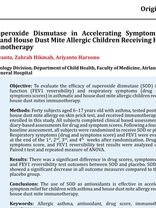Influence of an orally effective SOD on hyperbaric oxygen-related cell damage

作者:
M. Albicini, J. Kick, B. Hauser, U. Ehrmann, X. Leverve, P. Radermacher, G. Speit, C.M. Muth
雜誌:
Free Radic Res
Abstract
In a prospective, double-blind, randomised placebo-controlled study, we tested the hypothesis that a new formulation consisting of wheat gliadin chemically combined with a vegetal (thus orally effective) preparation of superoxide dismutase (SOD) allows to prevent hyperbaric oxygen (HBO)-induced oxidative cell stress. Twenty healthy volunteers were exposed to 100% oxygen breathing at 2.5 ATA for a total of 60 min. DNA strand breaks (tail moments) were determined using the alkaline version of the comet assay. Whole blood concentrations of reduced (GSH) and oxidised (GSSG) glutathione and F2-isoprostanes, SOD, glutathione peroxidase (GPx) and catalase (Cat) activities and red cell malondialdehyde (MDA) content were determined. After HBO exposure the tail moment (p = 0.03) and isoprostane levels (p = 0.049) were significantly lower in the group that received the vegetal formulation. Neither SOD and Cat nor GSH and GSSG were significantly affected by this preparation or HBO exposure. By contrast, blood GPx activity, which tended to be lower in the SOD-group already before the HBO exposure (p = 0.076), was significantly lower afterwards (p = 0.045). We conclude that an orally effective SOD-wheat gliadin mixture is able to protect against DNA damage, which coincided with reduced blood isoprostane levels, and may therefore be used as an antioxidant.
日期:
2004年9月1日
DOI:
......












